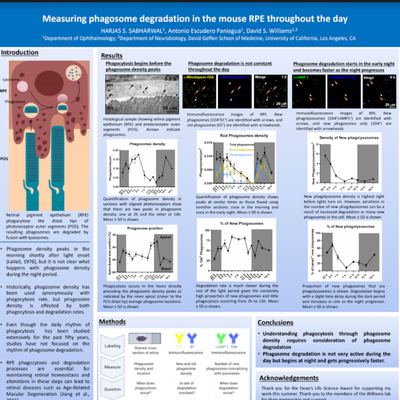
Harjas S. Sabharwal
Home Institution: UCLA
UCLA Mentor: Dr. David S. Williams
Program: Deans Award
Abstract:
Vision begins with the reception of light by opsins found in the photoreceptor outer segment (POS). Phototransduction causes oxidative stress to the POS, which leads to a build-up of damaged macromolecules that can cause retinal degeneration. To avoid degeneration, old POS tips are continuously phagocytosed by the nearby retinal pigment epithelium (RPE). Previous studies have shown that in the mouse, phagocytosis follows a circadian rhythm with a peak in phagosome density shortly after light onset. However, it is unknown whether phagocytosis is coordinated with phagosome degradation, an essential process for the proper functioning of RPE cells and the maintenance of retinal homeostasis. Therefore, we studied POS phagocytosis and degradation during the 24h cycle in the mouse retina. We found in vitro that phagocytosis and degradation are more active right before lights on. In vivo, we found that transition to darkness results in higher phagosome density two hours after the transition. These results suggest that opposite to current dogma, both phagocytosis and phagosome degradation are more active before light onset, when the highest phagosome density is found in the RPE cells. Our results provide key information regarding the daily cyclic nature of these two essential processes.

